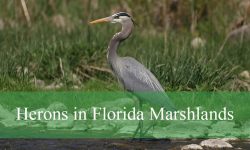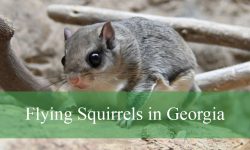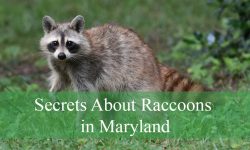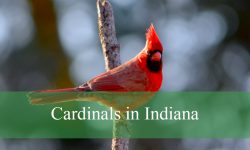Florida, with its warm and humid climate, is a haven for various types of roaches. Among the most common types of roaches in Florida are the American cockroach, known for its large size and reddish-brown color, and the German cockroach, which is smaller and light brown with two dark stripes on its back.
Additionally, the smoky brown cockroach and the Florida woods cockroach, often called the palmetto bug, are prevalent in the region. Understanding the types of roaches in Florida is crucial for effective pest control and maintaining a clean, healthy living environment.
There are about 35 species of roaches that can be found in Florida. Keep reading to learn about the characteristics, behaviors, and identification of these cockroach species.
Different Types of Roaches in Florida
Oriental Cockroach
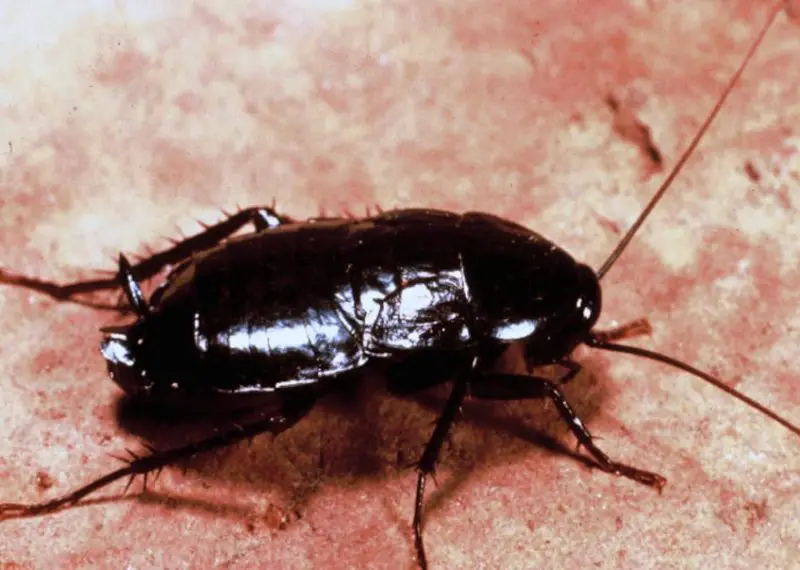
The Oriental Cockroach (Blatta orientalis) is adaptable, living both indoors and outdoors, with a robust tolerance for cold weather if it fails to find shelter indoors. Commonly entering homes via sewage pipes, where it feeds primarily, it also consumes decaying organic matter. This small roach poses problems for homeowners, particularly those who leave exposed garbage near their homes, attracting them indoors.
Considered a pest, pest controllers often check for Oriental Cockroach presence by inspecting spider webs, where these roaches frequently get trapped, indicating potential pest issues in homes.
Florida Beetle Roach
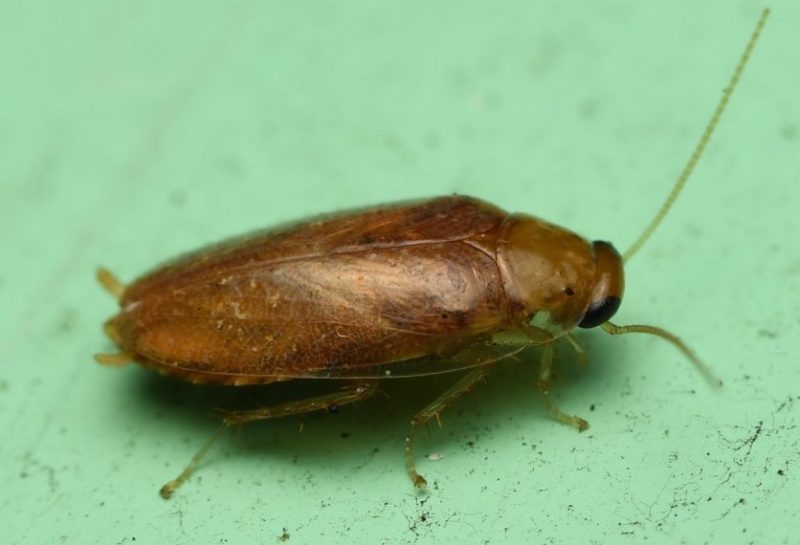
The Florida Beetle Roach (Plectoptera poeyi), a small species found in Florida and the Caribbean, belongs to the Plectoptera genus within the Ectobiidae family. With a distinctive brown head and body, it was first documented in 1862. This roach shares its lineage with the German Cockroach, Asian Cockroach, and Small Yellow Cockroach, indicating its evolutionary ties within the broader roach family.
Its presence in both Florida and Caribbean ecosystems highlights its adaptability to diverse habitats within tropical and subtropical regions of the Americas.
Chorisoneura Parishi
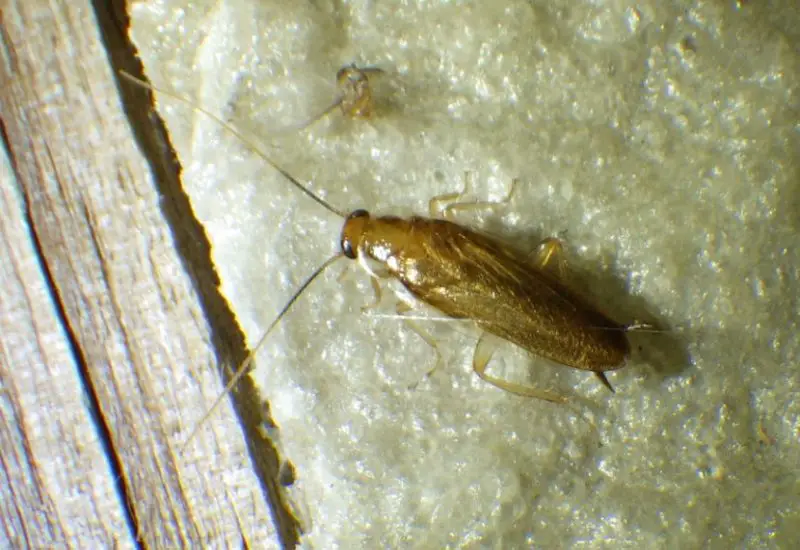
Chorisoneura parishi, first documented in 1918, is primarily found in Florida, extending into parts of Central and South America. Recognizable by its small, tan-colored body and shiny tan back of the head, this roach possesses long wings but lacks the ability to fly.
It frequents gardens during warm summer days, where it feeds predominantly on plants and leaves. Its preference for outdoor habitats and herbivorous diet underscores its ecological role and adaptation to warm climates throughout its geographic range.
Maya Cockroach
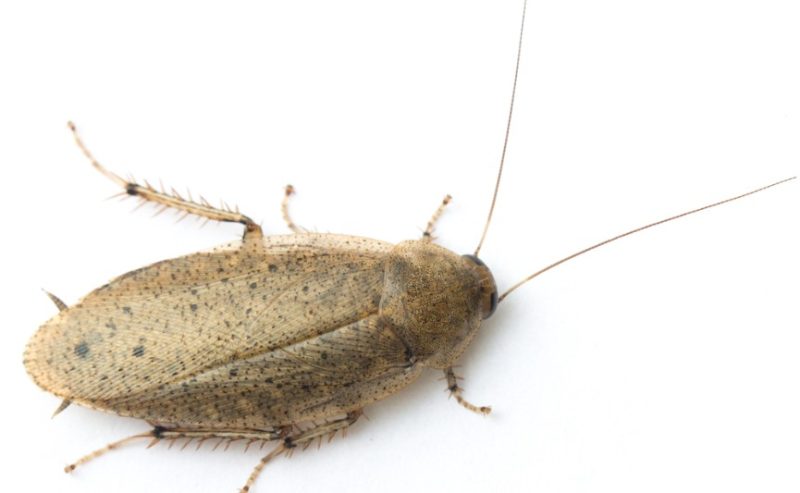
The Maya Cockroach (Epilampra maya), belonging to the Blaberidae family, is notable for its defensive behavior of submerging underwater when alarmed. This semi-aquatic species thrives near freshwater streams and is typically absent from homes in Florida.
It sustains itself by consuming decaying vegetation found in aquatic environments or adjacent to water sources. Adapted to its habitat, the Maya Cockroach’s preference for freshwater habitats and its unique defensive strategy highlight its specialized ecological niche within its natural range.
Discoid Cockroach
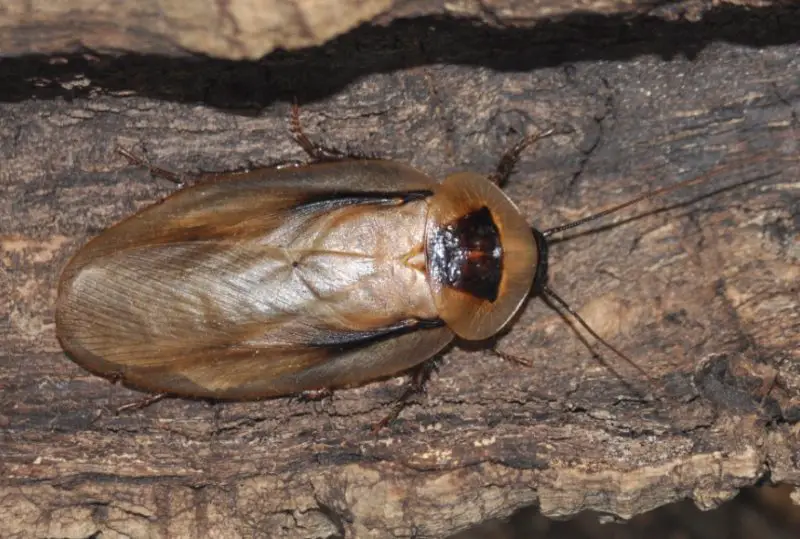
The Discoid Cockroach (Blaberus discoidalis) derives its name from its round body shape and large wings atop its back, though it cannot fly efficiently. Known for its wandering behavior without a clear direction, this species is commonly bred as food for other animals, particularly lizards kept as pets. Discoid Cockroaches breed rapidly and mature within a few months, reaching a maximum length of 35mm.
Their popularity as a food source stems from their nutritional value and ease of breeding, making them a favored choice among reptile enthusiasts.
Fulvous Wood Cockroach
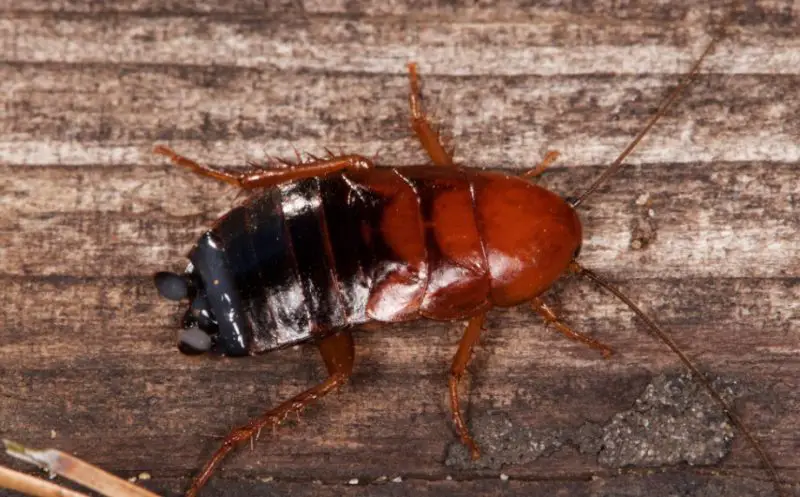
The red-brown Parcoblatta fulvescens roach (Fulvous Wood Cockroach) is commonly found in Florida’s swamps, oak forests, and pine forests, preferring habitats under leaves where it spends most of its life. This species is closely associated with mesic and xeric hammocks, thriving in Florida’s diverse hammock environments. Females of the species exhibit a more pronounced red coloration, while the male Fulvous Wood Cockroach displays a deeper brown hue.
Southern Wood Cockroach
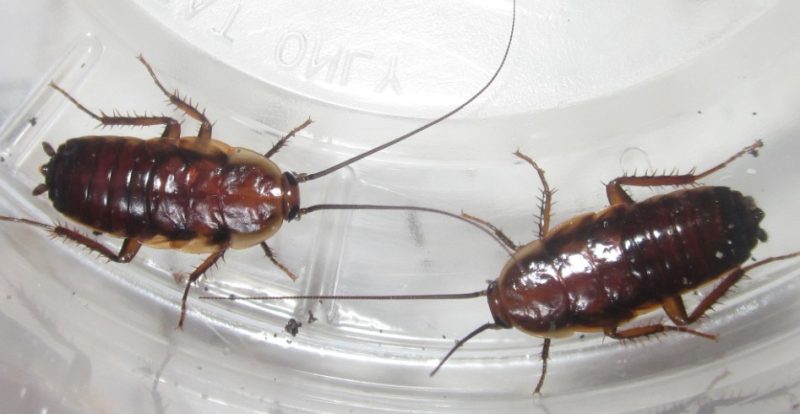
The Southern Wood Cockroach (Parcoblatta divisa) is characterized by its dark brown color and elongated body, reaching up to 17mm in length, though typically smaller at around 12mm. Found in woodlands abundant with timber, they also inhabit tall grass habitats and areas surrounding oaks and longleaf pines. These roaches thrive in environments rich in organic material, utilizing wood and vegetation for shelter and sustenance.
Tawny Cockroach
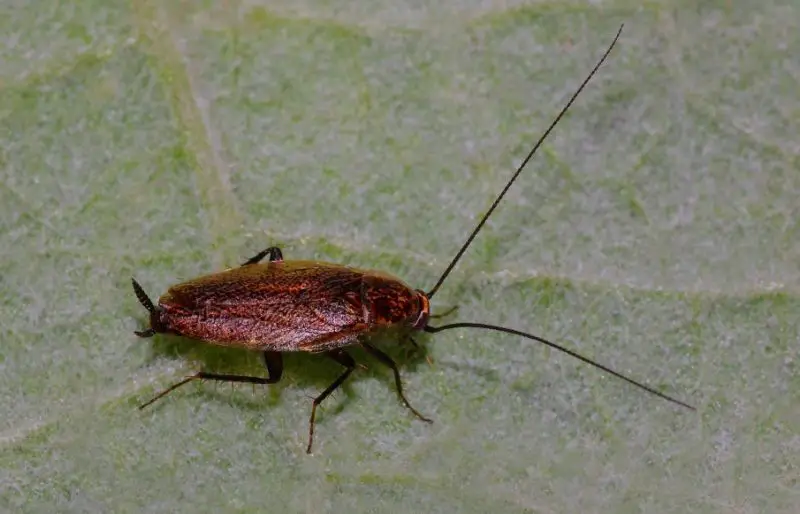
The Tawny Cockroach (Ectobius pallidus), found in Florida and various countries worldwide, including Europe, stands out with its yellow-golden coloration. It bears distinctive black spots on its body and small dots on its head, varying in number among individuals. Its legs also share the yellow-gold hue without black markings, mirroring its antennae.
This species’ striking appearance makes it easily identifiable in diverse habitats, where it adapts to local environments while maintaining its characteristic color patterns and markings.
Brown-Banded Cockroach
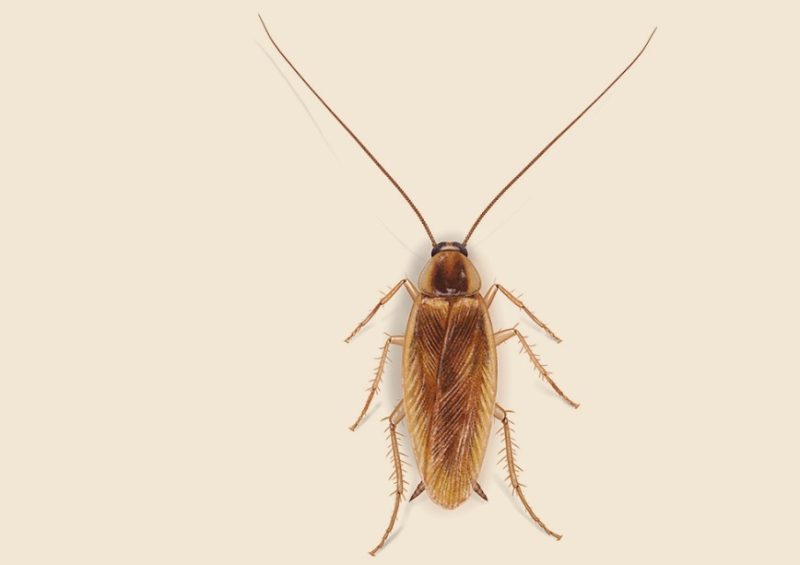
Similar to the German Cockroach, the Brown-banded Cockroach (Supella longipalpa) spends its entire life indoors. It shares a brown coloration with the German roach but lacks the distinctive black lines on its back. Preferring the warmth of indoor environments, it cannot survive outdoors in cold temperatures.
Considered a pest due to its potential to carry bacteria and infest food, this roach has been linked to various health issues in humans, including allergies. It commonly enters homes through small wall cracks, under doors, or via open windows that are inadvertently left accessible.
Aglaopteryx Gemma
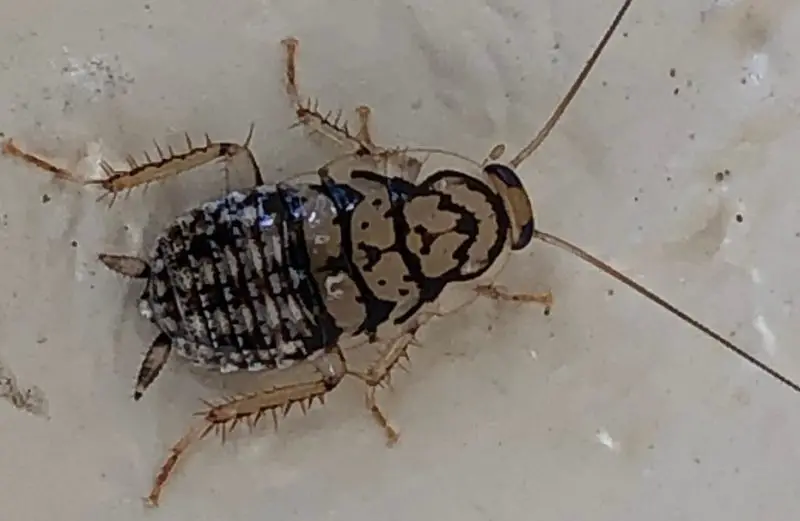
Aglaopteryx gemma, found in Southern US states like Florida and Georgia, is a pervasive household pest known to inhabit various areas of homes. It can be found resting in attics, living rooms, or basements. Distinguished by its back coloring resembling a bee, it features a black upper side with off-white markings and a lower side adorned with horizontal yellow and black lines, reminiscent of bees and wasps.
This unique appearance sets it apart from other common household roaches, making it recognizable to homeowners and pest control specialists alike.
Surinam Cockroach
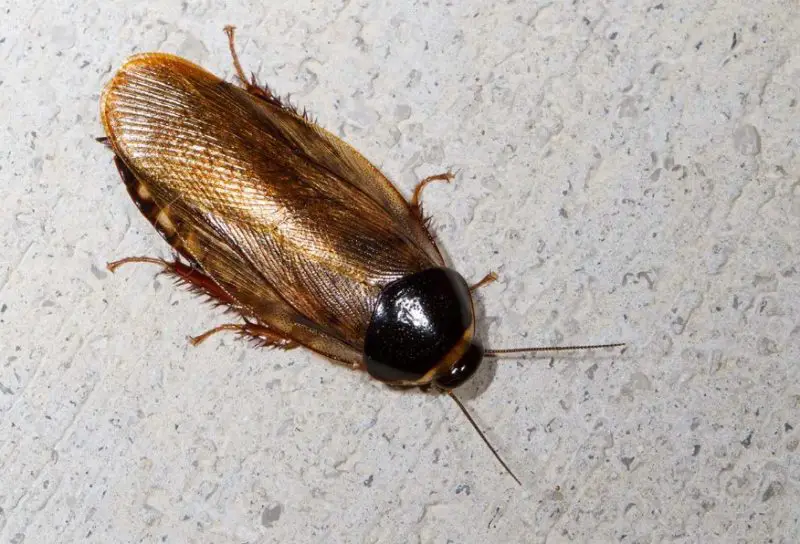
The Surinam Cockroach (Pycnoscelus surinamensis) is prevalent in the state, growing between 0.7 and 0.98 inches. It prefers living near man-made buildings, gardens, and crops, rarely venturing beyond. Mostly female, these roaches carry around 30 eggs, which hatch into nymphs.
Though they avoid living inside houses, they can infiltrate homes with potted plants. Proper plant treatments can deter them from indoor plants.
American Cockroach
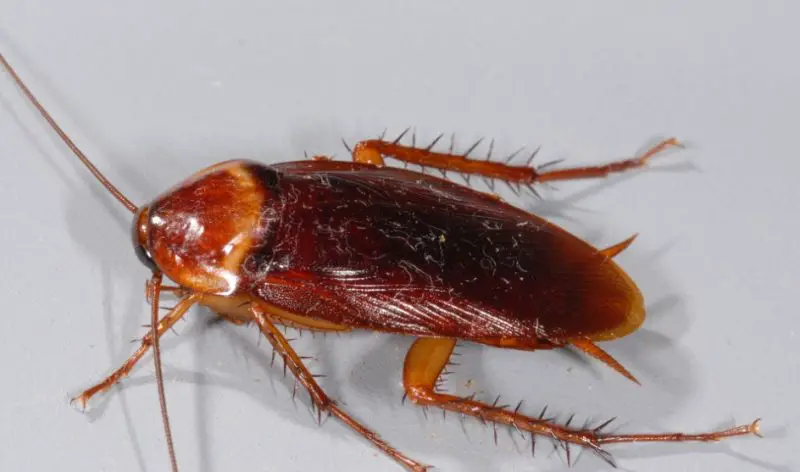
The American Cockroach (Periplaneta americana), common in Florida, is actually native to Africa. Found across the U.S., it prefers warm climates and shelters indoors during cold weather. This roach eats a variety of materials, including carpets, leather, food, and even dead animals, reaching up to 1.6 inches in length.
To keep it away, seal all cracks and remove food traces inside and outside the house. The American Cockroach has a lifespan of up to 700 days.
Florida Woods Cockroach
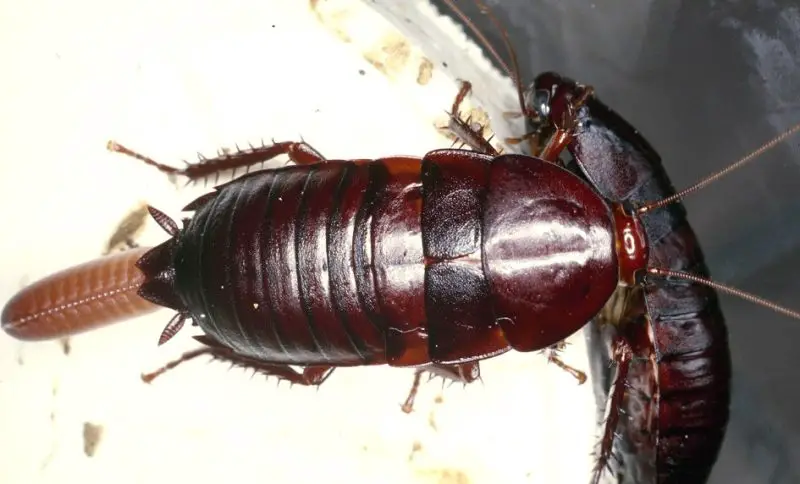
The Florida Woods Cockroach (Eurycotis floridana) is a red-brown roach known for its foul smell, released by males when alarmed. Although humans can detect the odor from a few feet away, these roaches prefer living in trees, around trees, or in abandoned buildings.
Native to the US, they thrive in warm, humid environments and avoid the sun, seeking damp, shaded areas. Occasionally, they enter houses, often found in bathrooms rather than kitchens due to their preference for high humidity.
Australian Cockroach
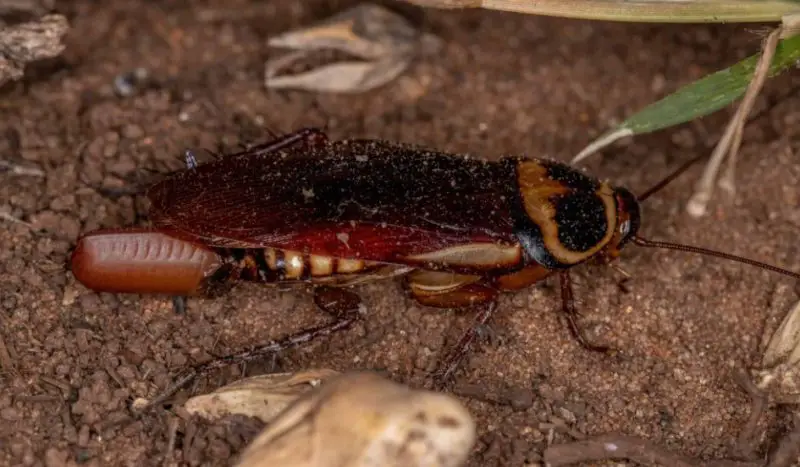
The Australian Cockroach (Periplaneta australasiae) has made its way to Florida, thriving in tropical climates with water sources. Unlike the Florida Woods Cockroach, it lives around buildings and occasionally seeks food and shelter indoors. Preferring humid environments, it can survive arid conditions if water is nearby.
With a varied diet, it consumes all types of food, including decaying matter. Growing over 1 inch, it is identifiable by its brown body and legs.
Banana Cockroach
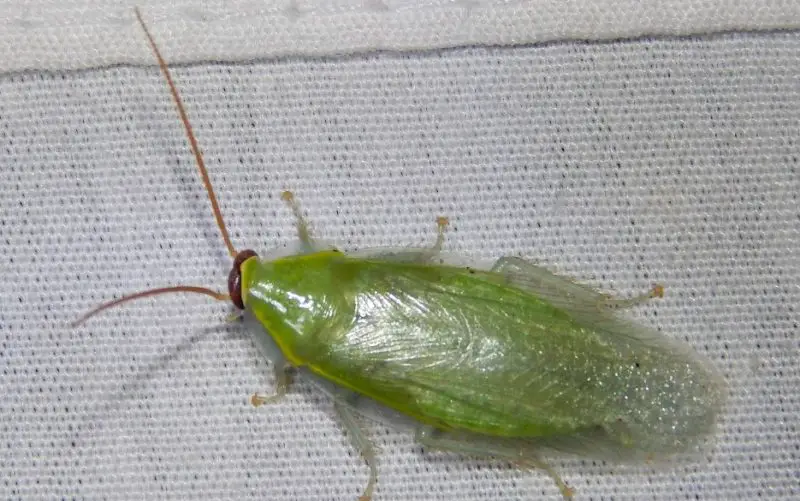
The Banana Cockroach (Panchlora nivea) has a pale green color and doesn’t live inside homes, so it isn’t considered a pest. Found only in Florida and Texas in the US, these roaches prefer living under trees, logs, and vegetation. Sometimes grown indoors due to their vivid color, they can reach up to 30mm in size and are often used as food for other animals. Prolific breeders lay up to 60 eggs at once, with nymphs maturing in around 180 days.
German Cockroach
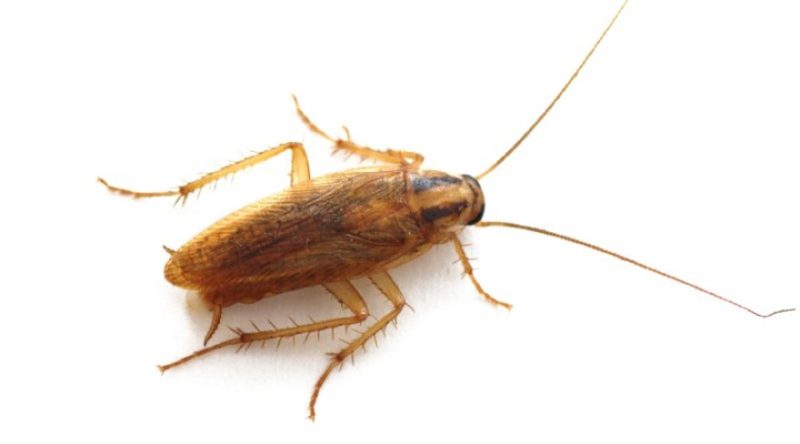
The German Cockroach (Blattella germanica) is the most troublesome household roach, breeding frequently and maturing faster than other roaches. This results in high numbers in places like restaurants, hotels, and homes. Originally from Africa, it established itself in Europe and then North America, becoming a feared pest.
It lives exclusively indoors, as it cannot survive cold weather. Preferring meats and fatty foods, it’s common in restaurants but can also eat soap and leather. Recognizable by its light brown color and long wings, it can glide to escape danger.
Dark Wood Cockroach
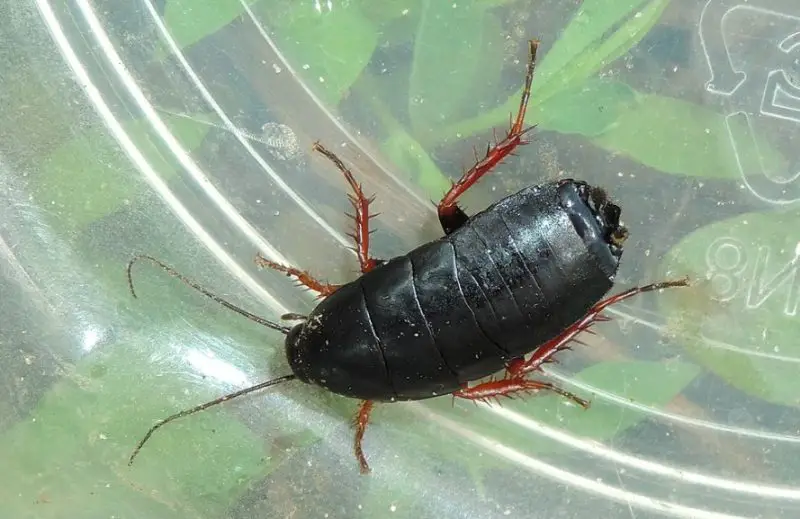
Dark Wood Cockroach (Ischnoptera deropeltiformis) roaches are characterized by their predominantly black body, with leg colors varying by age and sub-species—ranging from tan and amber to brown and bright red. While not considered pests, they can enter homes attracted to sources of light, like bulbs.
They prefer secluded areas, such as under firewood, emphasizing the need to inspect all wood brought indoors to prevent their entry. Vigilance in checking potential entry points and minimizing attractants can help manage their inadvertent intrusion into households.
Small Yellow Texas Cockroach
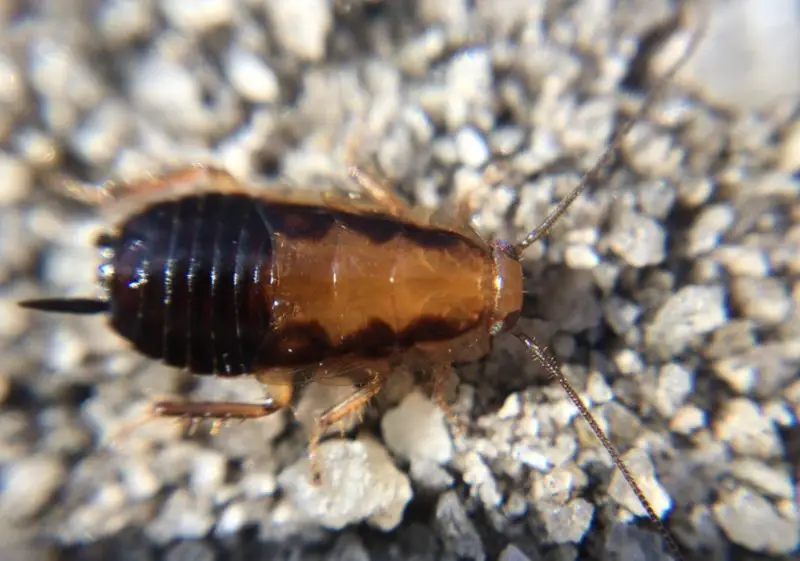
The Small Yellow Texas Cockroach (Chorisoneura texensis), a small roach prevalent in the Southern US, especially Florida and Texas, measures only a few millimeters and is difficult to spot on the ground outdoors. Its amber-yellow coloration makes it more noticeable when handled. This species encompasses numerous sub-species, with over 90 estimated variations, each exhibiting unique colorations and habitat preferences.
Despite its diminutive size, its diverse adaptations and widespread distribution across various environments underscore its resilience and ability to thrive in diverse ecological niches within its range.
Pale-Bordered Field Cockroach
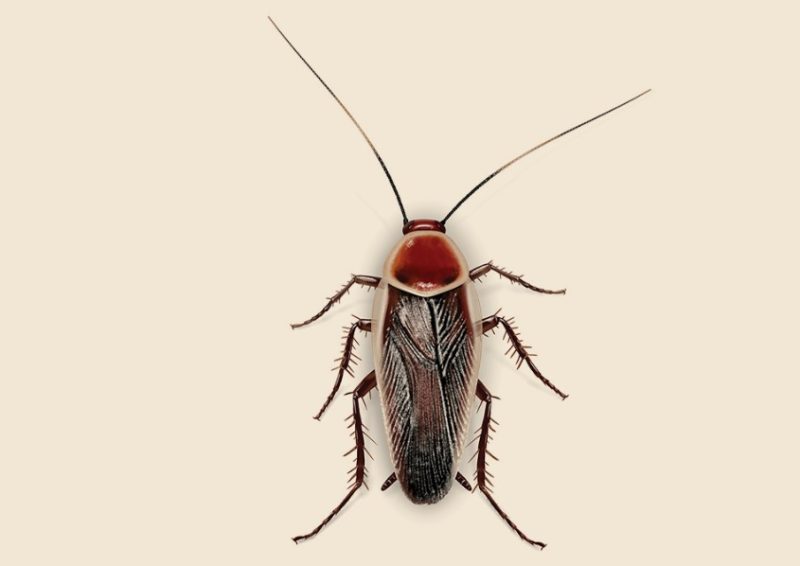
Pale-Bordered Field Cockroach (Pseudomops septentrionalis), named for the off-white lines along their wing edges, features a dark-colored body with a tan-brown head, making them easily recognizable in Florida. These roaches are not considered invasive and are among the more benign species, exclusively residing outdoors, especially in gardens.
They sustain themselves on fallen leaves and plant fibers, posing no threat to garden plants. While they may occasionally wander indoors, they do not establish colonies inside homes, preferring to dwell in garden settings adorned with flowers and vegetation.
Cariblatta Minima
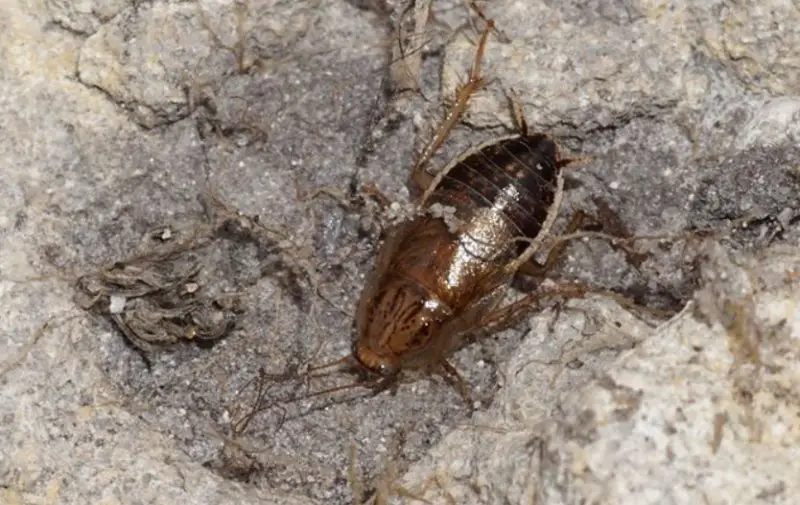
Cariblatta minima, a small brown roach belonging to the Ectobiidae family, inhabits peninsular Florida. Typically terrestrial, they prefer living outdoors on the ground, where they feed on wood and deposit larvae on decaying wood pieces.
When young, they exhibit a brown coloration, which darkens as they mature. This species’ adaptation to outdoor environments and preference for wood-based habitats underscore its role in natural decomposition processes within its ecosystem.
Brown Cockroach
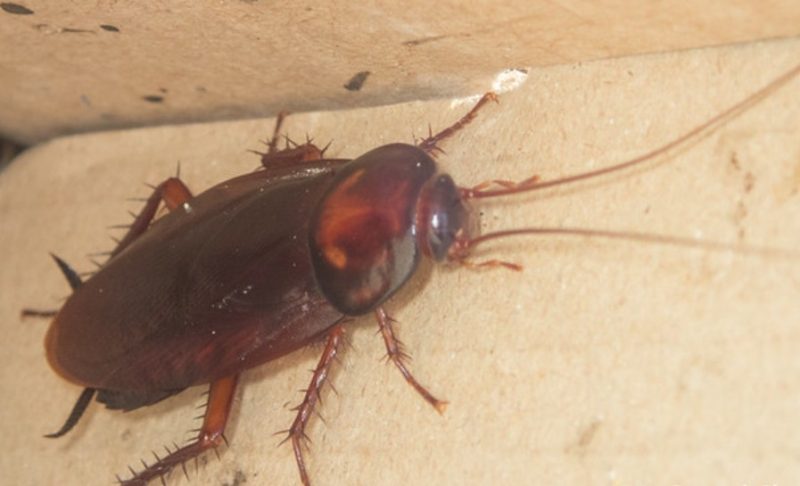
The Brown Cockroach (Periplaneta brunnea) closely resembles the American Cockroach but has a triangular body and brown coloration. Growing up to 2 inches long, it thrives in tropical, warm climates. Originating from Africa, this species produces fewer eggs per ootheca compared to other Florida roaches, typically containing around 24 eggs.
As adults, Brown Cockroaches are omnivorous, consuming a variety of foods, including vegetables and meat. Known for its adaptability and robust appetite, it can thrive in diverse environments, often becoming a nuisance in homes and urban settings.
Small Hooded Cockroach
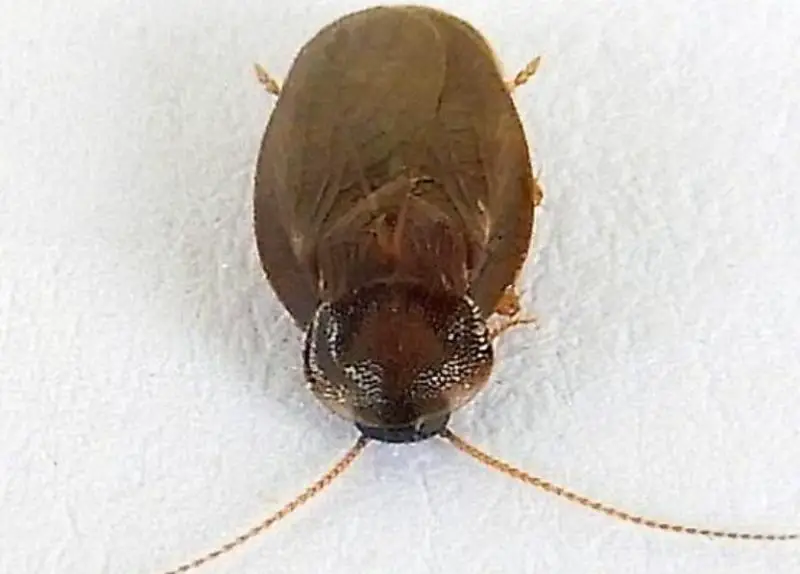
The Small Hooded Cockroach (Compsodes cucullatus), a diminutive species growing only to a few inches, belongs to the Compsodes genus. Typically found exclusively under the bark of deceased trees, these roaches feed on the wood within, nestling eggs deep inside the tree. They rarely venture outside their arboreal habitat if left undisturbed, showcasing a specialized adaptation to their environment.
Caudell’s Wood Cockroach
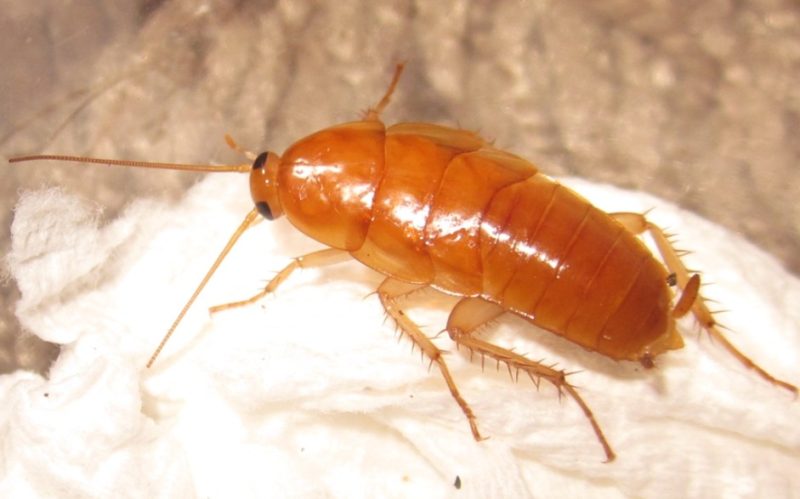
Caudell’s Wood Cockroach (Parcoblatta caudelli) is distinguished by its yellow-red head, black body, and red legs. Typically found in woodlands, dead trees, and often in sawdust, this species is native to the US and warrants further scientific study.
There is conflicting evidence regarding its flight capabilities, with some studies suggesting it can fly, particularly females, while others claim it cannot. As part of the Parcoblatta genus, known for its flight behavior towards light sources, ongoing research seeks to clarify its mobility and ecological role.
Asian Cockroach
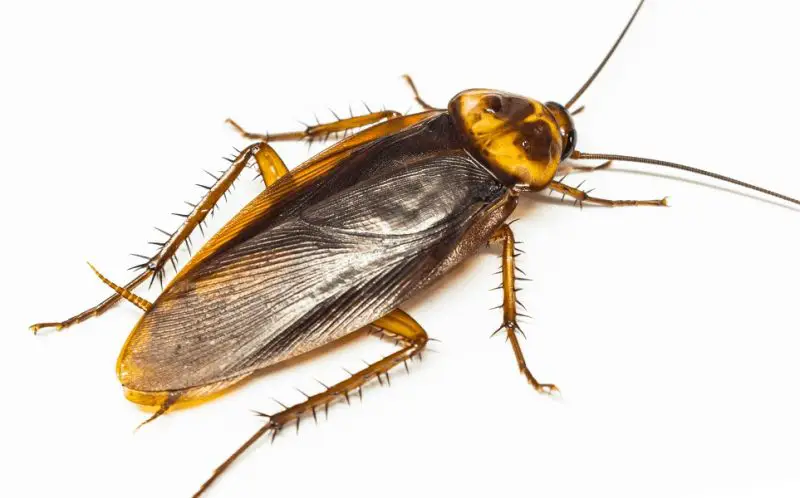
The Asian Cockroach (Blattella asahinai) closely resembles the German Cockroach but is considered beneficial, as it helps control larvae that damage cotton crops. While it has wings, it cannot fly long distances. Known for its vast summer colonies, particularly around agricultural fields, it can form colonies of up to 250,000, making it a prolific breeder.
Despite its benefits, it is feared due to its large numbers. The Asian Cockroach dies off as temperatures drop in the fall.
Smoky Brown Cockroach
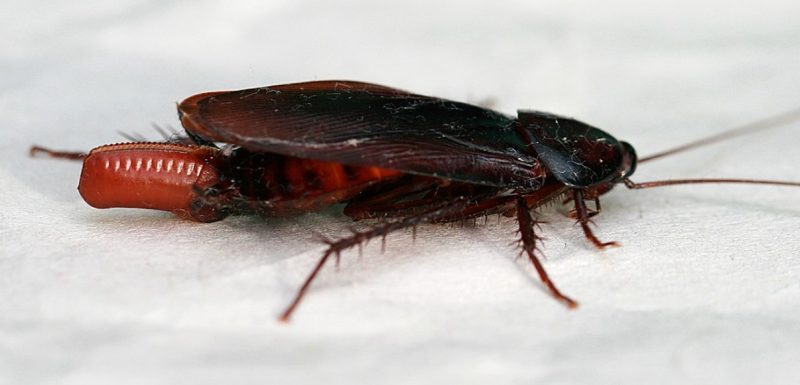
The Smoky Brown Cockroach (Periplaneta fuliginosa) can be distinguished by its dark color and markings on its back, unlike the larger American Cockroach. It reaches a maximum size of about a quarter of an inch in adulthood. Commonly found around and inside buildings, it lives both indoors and outdoors in Florida homes.
It enters homes primarily to forage for food and seek shelter from cold weather, preferring outdoor habitats near human-made structures during summer. It feeds on food leftovers and will enter houses if no food remains outside.
Neoblattella Detersa
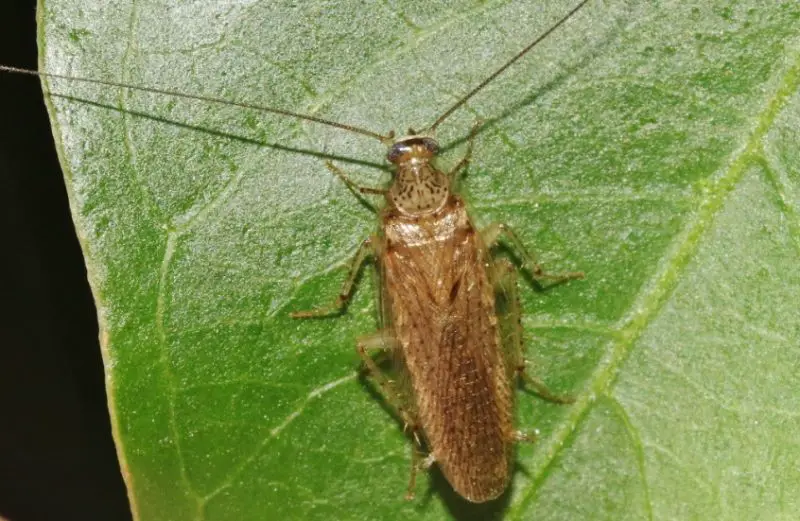
Neoblattella detersa, characterized by a black body with white lines and markings, belongs to the Ectobiidae family. Comprising several smaller sub-species, it exclusively lives indoors. These roaches prefer basements and kitchens, favoring humid environments. Nocturnal feeders emerge at night in search of food.
During winter, they often vanish completely due to their smaller size, which makes them susceptible to cold temperatures.
Rehn’s Cockroach
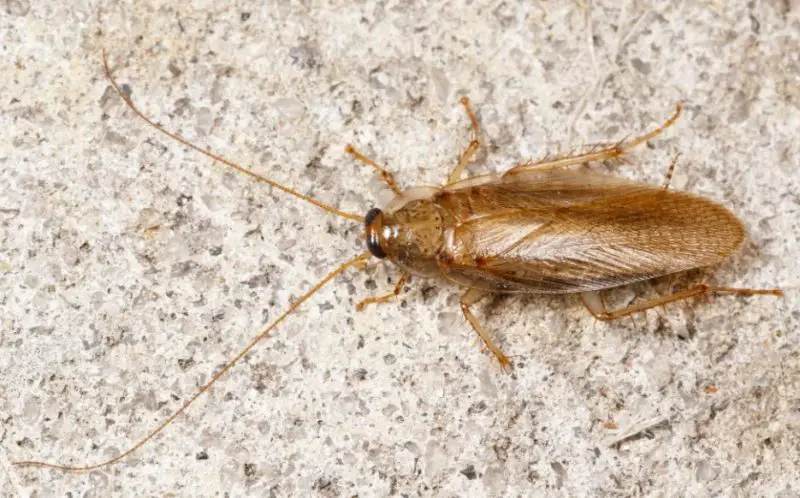
Rehn’s Cockroach (Latiblattella rehni) is distinguished by its brown-golden coloration. Belonging to the Ectobiidae family, it predominantly inhabits indoor environments, where it is commonly observed. This small roach has a relatively short lifespan, thriving mainly during the summer months when temperatures are warmer.
Recognizable by its long golden wings and head adorned with black markings, it is classified as a pest due to its presence and potential for infestation indoors.
Small Yellow Cockroach
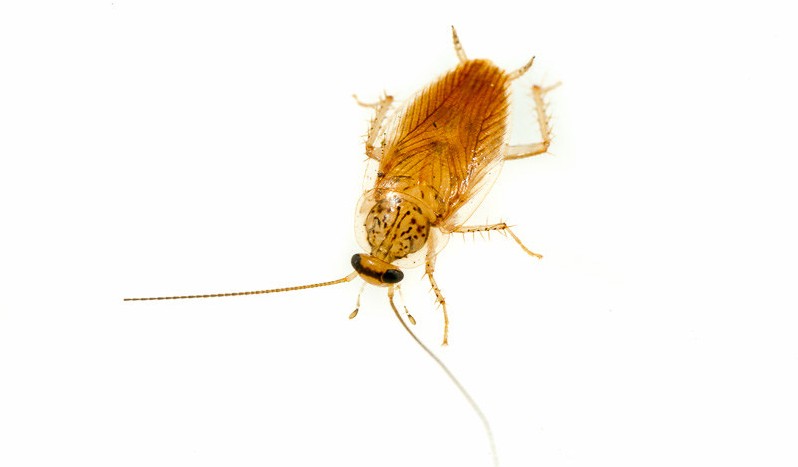
The Small Yellow Cockroach (Cariblatta lutea) is prevalent in Southern Peninsular Florida and is often found among hammock plants and tall grass near beaches. It is the smaller variant of Cariblatta lutea lutea, also found in the state. Both species are widespread, naturally occurring in pine plains, beach areas, and near water sources.
They inhabit pieces of wood, pine litter, and damp, shaded ground, avoiding direct sunlight. Due to their small size, up to a maximum of 7mm, they can be challenging to spot in natural environments.
Arenivaga Floridensis
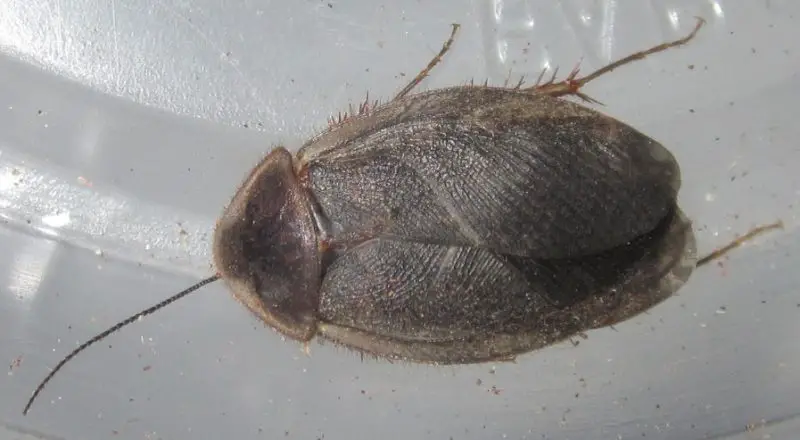
Native to Florida’s sand ridges, this species of roach thrives in sandy environments, facilitating easy digging. These warm areas provide thermal protection and safety for the green-brown roach. Belonging to the Corydiinae family, they inhabit sand burrows, including those of other mammals.
Known as wandering roaches, they are highly mobile, aided by their long antennae, which navigate them through soft, warm terrain. This adaptability allows them to flourish in their natural habitat within Florida’s sand ridges.
Bilunate Cockroach
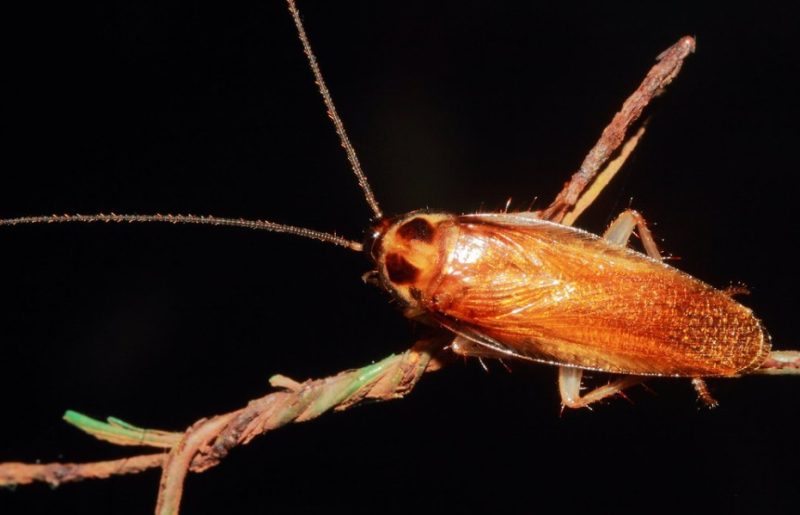
The Bilunate Cockroach (Ischnoptera bilunata) thrives in high humidity environments near water sources, preferring natural habitats but being capable of living indoors. It sports a brown-amber body with long wings reaching up to 1 inch in length.
Unique among roaches, it can fly, granting it speed and agility. Its ability to climb walls facilitates easy entry into houses. Popular as pet roaches due to their rarity in nature and attractive amber coloration, they mature quickly and are legally kept as pets, admired for their appearance and ease of care.

